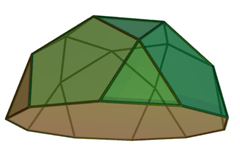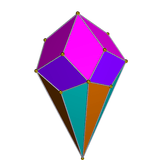Pentagonal rotunda
| Pentagonal rotunda | |
|---|---|
 | |
| Type |
Johnson J5 - J6 - J7 |
| Faces |
10 triangles 1+5 pentagons 1 decagon |
| Edges | 35 |
| Vertices | 20 |
| Vertex configuration |
2.5(3.5.3.5) 10(3.5.10) |
| Symmetry group | C5v |
| Rotation group | C5, [5]+, (55) |
| Dual polyhedron | - |
| Properties | convex |
| Net | |
 | |
In geometry, the pentagonal rotunda is one of the Johnson solids (J6). It can be seen as half an icosidodecahedron.
A Johnson solid is one of 92 strictly convex polyhedra that have regular faces but are not uniform (that is, they are not Platonic solids, Archimedean solids, prisms or antiprisms). They were named by Norman Johnson, who first listed these polyhedra in 1966.[1]
Formulae
The following formulae for volume, surface area, circumradius and height can be used if all faces are regular, with edge length a:[2]
Dual polyhedron
The dual of the pentagonal rotunda has 20 faces: 10 triangular, 5 rhombic, and 5 kites.
| Dual pentagonal rotunda | Net of dual |
|---|---|
 |
 |
References
- ↑ Johnson, Norman W. (1966), "Convex polyhedra with regular faces", Canadian Journal of Mathematics, 18: 169–200, doi:10.4153/cjm-1966-021-8, MR 0185507, Zbl 0132.14603.
- ↑ Stephen Wolfram, "Pentagonal Rotunda" from Wolfram Alpha. Retrieved July 21, 2010.
External links
This article is issued from Wikipedia - version of the 11/5/2015. The text is available under the Creative Commons Attribution/Share Alike but additional terms may apply for the media files.